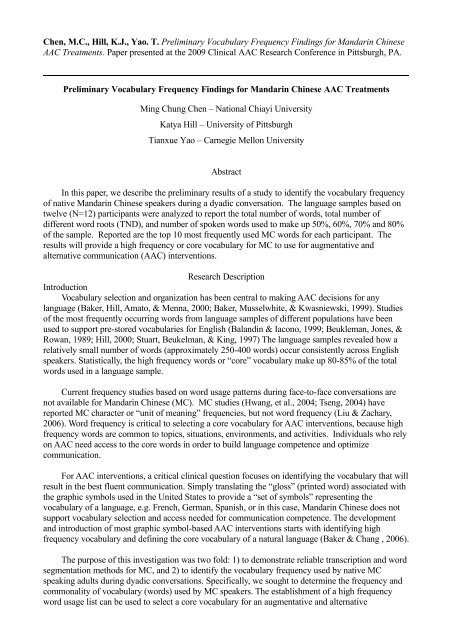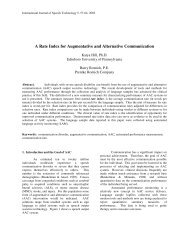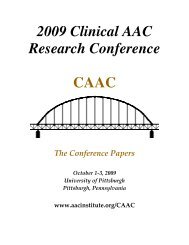Preliminary Vocabulary Frequency Findings for ... - AAC Institute
Preliminary Vocabulary Frequency Findings for ... - AAC Institute
Preliminary Vocabulary Frequency Findings for ... - AAC Institute
You also want an ePaper? Increase the reach of your titles
YUMPU automatically turns print PDFs into web optimized ePapers that Google loves.
communication (<strong>AAC</strong>) system and to support <strong>AAC</strong> treatment decisions.Method1.1ParticipantsTwelve adults (six male and six female) whose native language was Mandarin Chinese wererecruited <strong>for</strong> the study. The average chronological age of the participants was 39.8 (SD=18.4) with arange from 26 to 67 years. They all had a minimum of a high school diploma. No disabilities werereported.1.2Procedure of language sample collectingThe language sampling procedure was typical of previous studies harvesting conversationalsamples in closed environments (Graham & Hill, 2007; Stuart, et al., 1997). An interview wasconducted in the Per<strong>for</strong>mance and Testing Lab at the University of Pittsburgh. The language sampleswere collected after the participants became accustomed to talking under the condition of wearing themicrophone. The investigators started with introductory comments, explained the basic procedure,assured them that at any time they may stop the procedure, and offered that they may request a breakduring the one (1) hour if necessary. No specific topics were prompted <strong>for</strong> the conversation, but topicswere self-selected, spontaneous, and independent of the environment. The conversation wasconducted exclusively in Mandarin Chinese.1.3 InstrumentationA digital voice recorder equipped with a tie-clip omindirectional microphone was used to recordthe language sample. The recorded voice file was exported into a laptop with Microsoft Window XP(Mandarin version). The Mandarin Chinese version of Microsoft Word (Version 2003) was used totranscribe the audio tapes. In addition, an online word segmentation system developed by the <strong>Institute</strong>of In<strong>for</strong>mation Science and the <strong>Institute</strong> of Linguisticser of Academia Sinica in Taiwan(http://ckip.iis.sinica.edu.tw/CKIP/ wordsegment.htm) was used to segment the sentence into words.1.4Data analysisThe middle 20 minutes of each conversation were transcribed by the third author and a graduatestudent from the Department of Communication Science and Disorders at the University ofPittsburgh. Both transcribers are native MC speakers. We selected the sample <strong>for</strong> transcript topurposefully exclude introductory and closing remarks. We want the participants to be relaxed andcom<strong>for</strong>table with the surroundings and not thinking about the vocabulary they were using or could usewhile carrying on a conversation.Inter-rater reliability was calculated has the number of characters in both transcripts of aparticipant divided by the number of characters in the first transcript multiplied by 100. Thepercentage agreement based on 16% of the samples was 92% (range 90-94%).Each participant's transcript was automatically segmented to generate the word list using theCKIP system. This system segments words using criteria such as word length, morphemes, andprobability (Ma & Chen, 2003). The results from the CKIP segmentation step were saved and theword and its grammatical category were imported into SPSS 16.0 <strong>for</strong> data analysis. A text file of theword list <strong>for</strong> each participant was calculated. The frequency of each word was counted and the wordswere sorted by frequency. The cumulative percentage <strong>for</strong> word frequency was tabulated also to showthe number of different words that represented a given percentage of the language sample.2.Results
2.1Number of words used in the dialogueThe Results of calculating the words spoken by the twelve participants during the 20 minuteconversation using automated tools are shown in Table 1. The average number of total words was2329.9 (SD=536.6.) with a range from 1567 to 3225 spoken words. The total number of differentword roots (TND) used by the participants ranged from 380 to 718 word roots with a mean of 539.8root words (SD=113.8)The data revealed that 50% of the TND consisted of an average of 33.9 words (range of 29-39)<strong>for</strong> the participants. An average of 57.2 words (range 44-75) made up 60% of the total words used byparticipants. Finally, an average of 164.6 words (SD=33.7) was found to make up both 70% and 80%words used in the language samples.2.2Example <strong>for</strong> the high frequent wordsThe results of the top ten high frequency words by participants were shown in Table 2. As thetable indicated, these top 10 words made up 22% to 29% of the words used by the participant in the20 minute conversation. The results show that there is high overlap among the participants. Also, noneof the top 10 words are nouns.Table 1.Word frequency results <strong>for</strong> participants (N=12) <strong>for</strong> 20 minute language sample.subjectTotalwordsTND 50% 60% 70% 80%1 2596 644 38 64 113 1992 2445 640 33 59 107 2063 3225 642 35 56 98 1704 2744 615 36 59 98 1755 2273 518 36 56 89 1526 1709 453 34 54 90 1587 2875 585 35 57 100 1718 2233 430 29 46 74 1249 2741 718 39 63 118 22610 1618 415 33 53 88 14811 1567 380 29 44 71 11712 1933 437 30 75 75 1293.ConclusionsOur preliminary findings support the earlier attempts to identify MC vocabulary using automatedapproaches or MC databases. This early data analysis shows that a relatively small number of words(less than 200 words in this sample) will make up 80% of the spoken words used in conversation.These findings are similar to the vocabulary frequency studies in European languages anddemonstrate that high frequency words or core vocabulary is consistent across different speakers andtopics. The MC core vocabulary can be used as the foundation to support building language fluencyusing an <strong>AAC</strong> system.Table 2.Top 10 high frequency words/units of meaning used by the participants.
sub Top 10 words/units of meaning* %1 的 (DE)、 個 (GE)、 我 (I, me)、 那 (that)、 是 (to be)、 就 (just,then)、 了 (LE)、 很 (very)、 一 (a, one)、 這 (this)2 我 (I, me)、 的 (DE)、 是 (to be)、 個 (GE)、 那 (that)、 就 是 (itis)、 對 (right, yes)、 有 (to have)、 就 (just, then)、 啊 (ah)3 的 (DE)、 個 (GE)、 這 (this)、 他 (he, him)、 是 (to be)、 就(just, then)、 那 (that)、 種 (kind)、 一 (a, one)、 你 (you)4 的 (DE)、 個 (GE)、 是 (to be)、 我 們 (we, us)、 你 (you)、 我(I, me)、 那 (that)、 這 (this)、 有 (to have)、 一 (a, one)5就 (just, then)、 啊 (ah)、 的 (DE)、 去 (to go)、 說 (said)、 是(to be)、 對 (right, yes)、 我 們 (we, us)、 個 (GE)、 他 們 (they,them)6 的 (DE)、 對 (right, yes)、 啊 (ah)、 是 (SHI)、 有 (to have)、 就是 (it is)、 那 (that)、 我 (I, me)、 個 (GE)、 就 (just, then)7 我 (I, me)、 的 (DE)、 就 (just, then)、 是 (to be)、 都 (all,both)、 啊 (ah)、 你 (you)、 要 (want)、 我 們 (we, us)、 啦 (LA)8的 (DE)、 是 (to be)、 我 (I, me)、 你 (you)、 他 們 (they,them)、 那 (that)、 他 (he, him)、 對 (right, yes)、 有 (tohave)、 個 (GE)9 我 (I, me)、 的 (DE)、 就 (just, then)、 然 後 (then)、 是 (tobe)、 去 (to go)、 個 (GE)、 那 (that)、 要 (want)、 很 (very)10 的 (DE)、 是 (to be)、 有 (to have)、 也 (also)、 嗯 (um)、 對(right, yes)、 啊 (ah)、 那 (that)、 個 (GE)、 你 (you)11 的 (DE)、 我 (I, me)、 就 (just, then)、 那 (that)、 你 (you)、 是(to be)、 就 是 (it is)、 有 (to have)、 嗯 (um)、 不 (not)29.224.728.825.322.529.324.128.423.126.626.712 的 (DE)、 嗯 (um)、 對 (right, yes)、 我 (I, me)、 會 (will)、 是28.9(to be)、 個 (GE)、 那 (that)、 就 是 (it is)、 就 (just, then)*capitalized letters in parentheses indicate pronunciation of MC character; Englishword <strong>for</strong> MC character(s) provided in parentheses were appropriate.
ReferenceBaker, B., Musselwhite, C., & Kwasniewski, K. (1999). Literacy, language, and minspeak: Corevocabulary is the key. Presentation <strong>for</strong> the Summer Seminar on Literacy and <strong>AAC</strong>. Durham, NC.Baker, B. & Chang, S. (2006). A Mandarin language system in augmentative and alternativecommunication (<strong>AAC</strong>). International Journal of Computer Processing of Oriental Languages, 19,225-237.Baker, B., Hill, K., Amato, J., & Menna, D. (2000, August). Do we liberate individuals byteaching wide context specific vocabulary? In Proceedings of the 9th International Society <strong>for</strong>Augmentative and Alternative Communication Biennial Conference(pp 727-729). Washington DC:IS<strong>AAC</strong>.Balandin, S. & Iacono, T. C. (1999). Wusses, and whoppas: Core and fringe vocabularies ofAustralian meal-break conversations in the workplace. Augmentative and AlternativeCommunication, 15, 95-109.Beukleman, D. R., Jones, R., & Rowan, M. (1989). <strong>Frequency</strong> of word usage by nondisabledpeers in integrated preschool classrooms. Augmentative and Alternative Communication, 5, 243-248.Graham, K. & Hill, K. (2007, September). A Pilot Study Comparing <strong>AAC</strong> <strong>Vocabulary</strong> UsagePatterns Based on User Experience. Poster presented at the 2007 Clinical <strong>AAC</strong> Research Conference.Lexington, KY.Hill, K.(2001). The development of a model <strong>for</strong> automated per<strong>for</strong>mance measurement and theestablishment of per<strong>for</strong>mance indices <strong>for</strong> augmented communicators under two sampling conditions.Ph.D. Thesis, University of Pittsburgh, Pittsburgh, PA.Hwang, M. Y., Lei, X., Ng, T., Bulyko, I., Ostendorf, M., Stolcke, A., et al., (2004, December).Progress on mandarin conversational telephone speech recognition. In Proceedings of the FourthInternational symposium on Chinese spoken language processing. (pp. 1-4). Hong Kong: ChineseUniversity of Hong Kong.Liu, C. & Zachary, S. (2006). Developing a core vocabulary <strong>for</strong> a mandarin Chinese <strong>AAC</strong>system using word frequency data. International Journal of Computer Porcessing of OrientalLanguages. 19, 285-300.Ma, W. Y., & Chen, K. J. (2003, July). Introduction to CKIP Chinese Word SegmentationSystem <strong>for</strong> the First International Chinese Word Segmentation Bakeoff. Proceedings of ACL, SecondSIGHAN Workshop on Chinese Language Processing(pp. 168-171). Sapporo, Japan.Stuart, S., Beukelman, D. R., & King, J. (1997). <strong>Vocabulary</strong> use during extended conversationsby two cohorts of older adults. Augmentative and Alternative Communication, 13, 40-47.Tseng, S. C. (2004, December). Spontaneous mandarin production: Results of a corpus-basedstudy. In Proceedings of the Fourth International Symposium on Chinese Spoken LanguageProcessing (29-32). Hong Kong: Chinese University of Hong Kong.





